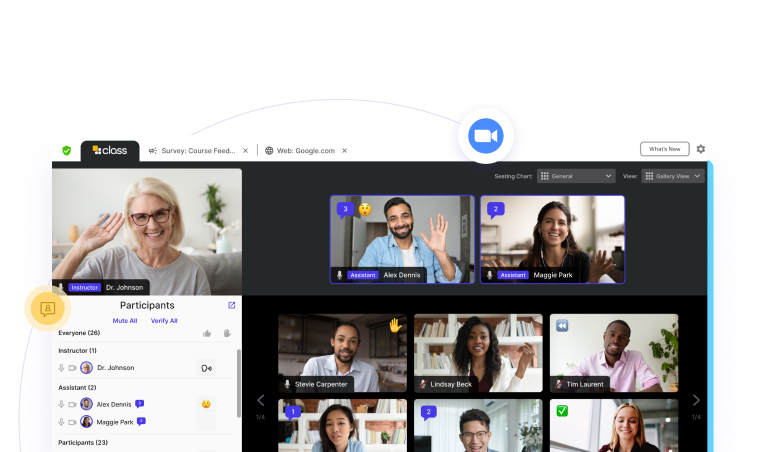
Daniel Hansen is an award-winning sales leader and VP of Corporate Sales at Class. He has a proven track record of building high-performing teams and attaining quotas in over 15 years of selling software. Prior to Class, he spent nine years in the virtual classroom space.

Daniel Hansen is an award-winning sales leader and VP of Corporate Sales at Class. He has a proven track record of building high-performing teams and attaining quotas in over 15 years of selling software. Prior to Class, he spent nine years in the virtual classroom space.

As a business expands, teams become more geographically dispersed, and scaling training programs to match gets increasingly complex. An emerging solution to this predicament is virtual instructor-led training (VILT), which is proving to meet the demand for flexible, remote learning experiences. But is the quality of remote experiences as good as traditional, in-person training programs? That’s the question many learning and development professionals are asking themselves. Quality is of extreme importance for companies, with 51% of HR managers saying employee training is their main way of closing skills gaps in their organizations.
Virtual learning programs need to deliver impactful training to larger audiences without losing the personal touch and interactive elements that make teaching effective. The upside is that there’s a proven, successful way to do this with purpose-built virtual training programs. In this guide, I’ll explore strategies for scaling VILT while ensuring that each learner receives the same high-quality experience they would in person.
You need to be intentional about maintaining quality and engagement when designing your plan to implement virtual training programs. Use the following strategies to guide you through creating a plan that meets your learners’ needs and supports your organization’s goals.
Develop structured training frameworks with clear learning objectives to create a consistent learning experience as you scale. Use standardized facilitator guides, lesson plans, and assessments to help instructors deliver the same high-quality experience across teams and locations. Aligning your training goals to your company goals and industry best practices also helps, allowing you to maintain a unified approach that delivers the right outcomes.
Combine synchronous (live) with asynchronous (self-paced), sessions to scale VILT while maintaining flexibility for participants. Pre-session materials can set the stage for live interactions, while post-session reinforcement materials help with knowledge retention. Encourage peer-to-peer learning through cohort programs, discussion forums, and mentorship initiatives to enhance engagement and create a sense of community that helps learners connect with the content, each other, and the instructor.
To scale VILT effectively, you’ll want to optimize your instructors’ delivery methods and provide them with quality training to facilitate virtual courses. Train staff and subject matter experts to build a steady pipeline of qualified instructors, and when you’re choosing content delivery methods, use activities like co-facilitation and breakout sessions to manage larger groups and allow for more interactive and personalized experiences. Implement train-the-trainer programs so knowledge can transfer at scale, and design modular training content so it’s easier to understand and adapt as needed, keeping training relevant over time.
Consistent evaluation is essential to running a successful, large-scale training program. Establish key performance indicators (KPIs) for engagement, knowledge retention, and overall training effectiveness to track progress and identify areas for improvement. Gather feedback through surveys, analytics, and performance data to make iterative adjustments to the training program and make sure it’s continuing to meet the needs of your growing workforce. If you’re unsure about how to build the infrastructure to track the right KPIs, think about using a virtual training program with built-in analytics, so you have the functionality you need out of the gate.
The tools in your virtual toolbelt will determine how smoothly your programs run and how quickly they scale. Invest in a purpose-built virtual classroom with features like breakout rooms, real-time polling, and interactive whiteboarding. These features go beyond what standard video conferencing tools offer, making for a more dynamic learning environment. Investing in a good learning management system is also key and will allow you to centralize access to training materials and automate processes like enrollment, tracking assessments, and certifications. This functionality will make your entire training experience more streamlined and efficient.
Data analytics is a game changer when it comes to scaling virtual training. By collecting insights into learner participation, performance trends, and content effectiveness, you can make more informed decisions about your training programs. AI-powered recommendations help personalize learning paths, optimizing the experience based on the specific needs and progress rates of individual learners. These data-driven insights enable continuous improvement and help your VILT programs evolve based on needs and organizational changes.
Successfully scaling VILT without sacrificing quality requires the right combination of strategy, technology, and ongoing adaptation. Prioritizing structure, engagement, and continuous improvement helps organizations scale their training programs to support teams of all sizes while ensuring that every learner receives a meaningful, high-quality experience. The strategies outlined in this guide—from standardizing training content to leveraging data analytics—should provide a roadmap to help navigate the complexities that arise as you scale your training programs.
What’s the main key to success? Make sure you create a balance between well-designed training frameworks and the right technology to enhance both delivery and engagement. This balance makes scaling more efficient and ensures that your training programs remain impactful, regardless of the number of participants or their locations.
As you assess your current training model, evaluate where improvements can be made. Are there opportunities to implement scalable strategies or tech solutions that could further streamline processes and enhance program success? If you take a proactive, thoughtful approach to scaling VILT, you’ll be able to create a training program that continuously drives performance, engagement, and success.
If you’re ready to start scaling now, Class can help. Contact us to connect with a Class representative and explore how our platform can help you scale your virtual training programs while maintaining the highest quality standards.

Daniel Hansen is an award-winning sales leader and VP of Corporate Sales at Class. He has a proven track record of building high-performing teams and attaining quotas in over 15 years of selling software. Prior to Class, he spent nine years in the virtual classroom space.

Daniel Hansen is an award-winning sales leader and VP of Corporate Sales at Class. He has a proven track record of building high-performing teams and attaining quotas in over 15 years of selling software. Prior to Class, he spent nine years in the virtual classroom space.
Get our insights, tips, and best practices delivered to your inbox

Sign up for a product demo today to learn how Class’s virtual classroom powers digital transformation at your organization.

Features
Products
Integrations